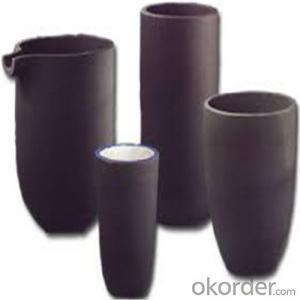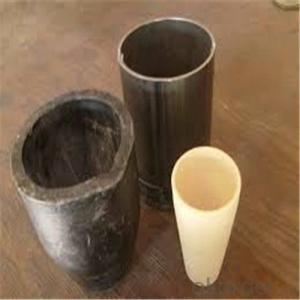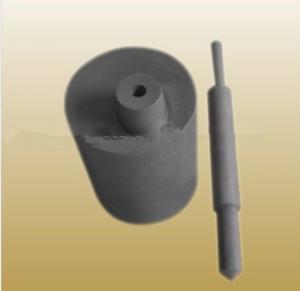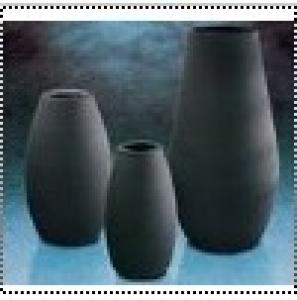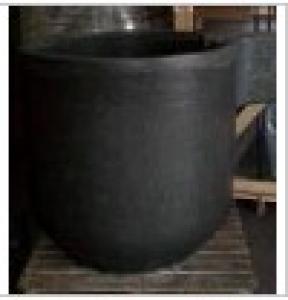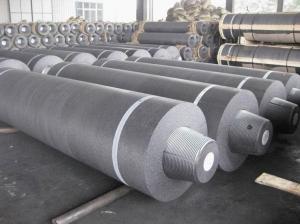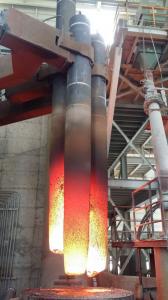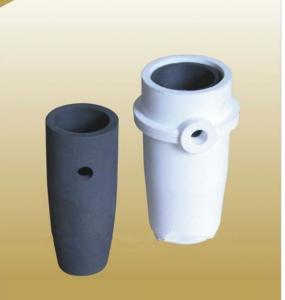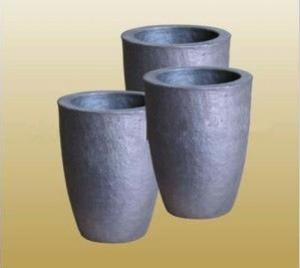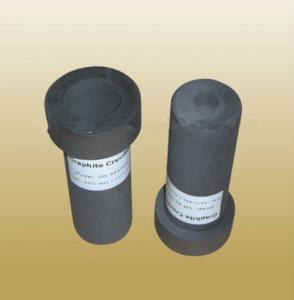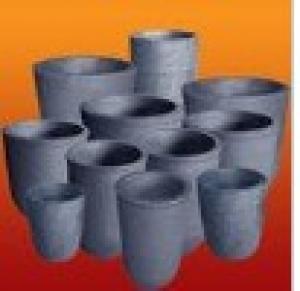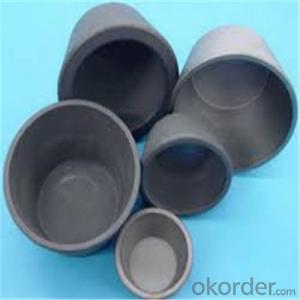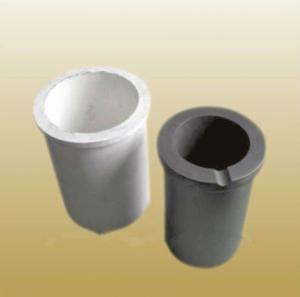Clay Graphite Crucible,SiC Crucibles For Melting Aluminium And Copper, Brass
- Loading Port:
- Shanghai
- Payment Terms:
- TT OR LC
- Min Order Qty:
- 1 pc
- Supply Capability:
- 1000 pc/month
OKorder Service Pledge
OKorder Financial Service
You Might Also Like
Quick Details for SiC Graphite Crucibles
| Type: | High Strength, graphite crucible crucible | Application: | melting metal | Height: | as your requirements |
| Composition: | High Pure | Top Diameter: | 10-600mm | Bottom Diameter: | 10-1000mm |
| Place of Origin: | China (Mainland) | Brand Name: | Model Number: | ||
| Color: | Black grey | Si3N4%: | 5min | Fe2O3%: | 0.7max |
| C%: | 30-45 | Apparent porosity: | 30max | Refractoriness: | 1680 |
| Bulk Density: | 1.71min | Using life: | >5000 hours | MAX temperature: | 1600c |
Packaging & Delivery
| Packaging Details: | Seaworty packing or as per customer's detail requirement of graphite crucible. |
| Delivery Detail: | within 20-30 days after confirm order of graphite cru |
SiC Graphite Crucibles For Melting Aluminium And Copper, Brass
Product Description
Specifications for Graphite Silicon Carbide Crucible For Aluminum Melting :
1.Long working lifetime: its working lifetime is increased 3-5 times over normal clay-crucible due to the compact body formed under high pressure.
2.High thermal conductivity: high-density body and low apparent porosity greatly improve its heat conductivity.
3.New-style materials: new heat conduction material ensures faster heat conductivity and pollution-free product, reduces adherent slag.
4.Resistance to corrosion:better anti-corrosion than normal clay-crucible.
5.Resistance to oxidation: advanced process dramatically improves its oxidation resistance, which ensures persistent heat conductivity and long working lifetime.
6.High-strength: high-density body and logical structure make the product better compression property.
7.Eco-friendly: energy-efficient and pollution-free, not only ensure metal product purity, but also ensure sustainable development on environment.
8.Multi-function: Can be used in induction graphite crucible furnace
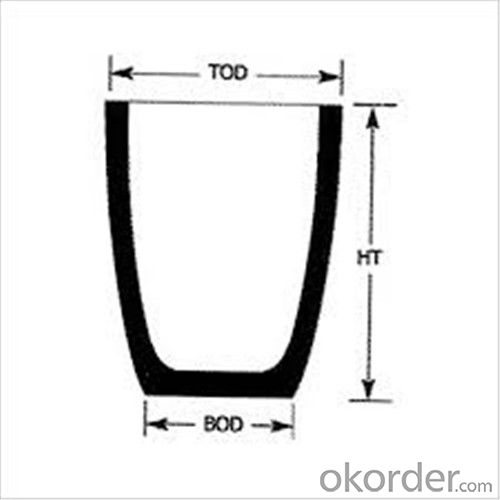

Physicochemical Properties
Type of Crucible | Type S | Type D |
Carbon Content/% | ≥38 | ≥45 |
Bulk Density/(g/cm3) | ≥1.70 | ≥1.85 |
Apparent Porosity/% | ≤29 | ≤21 |
Compression Strength/MPa | ≥20 | ≥25 |
Refractoriness/°C | ≥1400 | ≥1400 |
Type S: Clay graphite crucible
Type D: Isostatic pressing graphite crucible
Cited from CNS China National Standard of Graphite Crucible, which is solely drifted by TIANFU company.
Content Composition
C% | Sic% | AL2O3% | SIO2% |
45%-50% | 20%-30% | 10%-12% | 15-25% |
- Q:Are there any special precautions to be taken while using graphite crucibles?
- Yes, there are several special precautions that should be taken while using graphite crucibles. First, it is important to handle graphite crucibles with care as they are fragile and can break easily. Avoid dropping or mishandling them to prevent cracks or damage. Secondly, graphite crucibles should be stored in a clean and dry environment to prevent any contamination. Graphite is susceptible to absorbing impurities from the surroundings, which can affect its performance and durability. During use, it is crucial to avoid exposing graphite crucibles to rapid temperature changes. Sudden heating or cooling can cause thermal shock, leading to cracks or even breakage. To prevent this, it is recommended to gradually heat or cool the crucible within the recommended temperature range. Additionally, graphite crucibles should be properly seasoned or preheated before using them for the first time. This involves slowly heating the crucible to a specific temperature to remove any moisture or volatile substances that might be present. Failure to properly season the crucible can lead to cracking or premature failure during subsequent use. Furthermore, it is important to avoid overloading the crucible with excessive material. Graphite crucibles have specific capacity limits, and exceeding these limits can cause the crucible to fail or reduce its lifespan. Lastly, when handling molten materials or pouring them into the crucible, appropriate personal protective equipment should be worn. This includes heat-resistant gloves, face shields, and other protective clothing to prevent burns or injuries. By following these precautions, users can maximize the lifespan and performance of graphite crucibles while ensuring safe and effective use.
- Q:What are the different methods of monitoring the melting process in a graphite crucible?
- There are several methods available for monitoring the melting process in a graphite crucible. These methods can provide valuable information about the temperature, consistency, and progress of the melting process. 1. Visual Inspection: One of the simplest methods is to visually inspect the melting process. This can be done by observing the color, consistency, and movement of the materials being melted. For example, if the materials are turning into a liquid state and flowing smoothly, it indicates that the melting process is progressing as expected. 2. Thermocouples: Thermocouples are widely used for temperature measurement in various industrial processes, including melting in graphite crucibles. These devices consist of two different metals joined together at one end. By measuring the voltage difference between the two ends, the temperature can be determined. Thermocouples can be inserted into the crucible or placed near it to monitor the temperature accurately. 3. Infrared Pyrometers: Infrared pyrometers are non-contact temperature measurement devices that use infrared radiation to determine the temperature of an object. They can be used to monitor the temperature of the graphite crucible during the melting process without physically touching it. Infrared pyrometers provide quick and accurate temperature readings. 4. Optical Emission Spectroscopy (OES): OES is a technique that analyzes the light emitted by the materials being melted to determine their composition and temperature. By analyzing the spectral lines and intensities of the emitted light, OES can provide valuable information about the melting process, including temperature and the presence of impurities or alloying elements. 5. Pressure Measurement: Monitoring the pressure inside the graphite crucible can also be an indicator of the melting process. As the materials melt and vaporize, the pressure inside the crucible may increase. Pressure sensors can be employed to measure the pressure changes during the melting process, providing insight into the progress of the melting and the behavior of the materials. These methods can be used individually or in combination to monitor the melting process in a graphite crucible. By employing one or more of these techniques, operators can ensure that the melting process is proceeding as intended and make any necessary adjustments or interventions to maintain optimal conditions.
- Q:What are the common uses of graphite?
- As a wear-resistant and lubricating material, graphite is often used as a lubricant in the mechanical industry. Lubricants can not be used in high speed, high temperature, high pressure conditions, and graphite wear-resistant materials can be at -200 - 2000 temperature, and at a high sliding speed, without lubricating oil work. Many transporting corrosive media devices are widely used, which is made of graphite material piston ring, the sealing ring and the bearing, they are running, without adding lubricating oil, graphite and many metal processing (drawing, drawing) the good lubricant.
- Q:How do you prevent graphite crucibles from cracking during cooling?
- There are several measures that can be taken to prevent graphite crucibles from cracking during the cooling process: 1. Gradual cooling is essential to avoid thermal shock and stress-induced cracks. To achieve this, one can place the crucible in a designated cooling area or inside an oven with controlled cooling rates. 2. Thermal insulation materials, like ceramic fibers or refractory bricks, can be utilized to regulate the cooling rate and minimize temperature gradients. These materials act as a buffer against sudden temperature changes that might lead to cracking. 3. It is recommended to preheat a new graphite crucible gradually before use to eliminate any moisture or volatile impurities. Additionally, annealing the crucible at a low temperature can relieve internal stress and enhance its resistance to cracking during subsequent usage. 4. Direct contact with water or coolants should be avoided immediately after use or during the cooling process, as rapid cooling and thermal shock can result in cracks. Instead, it is advisable to let the crucible cool naturally in a dry environment. 5. Proper handling and storage of graphite crucibles are crucial. Care should be taken to prevent accidental impacts or drops that can cause cracks. When not in use, the crucibles should be stored in a dry and temperature-controlled environment to maintain their structural integrity. By following these preventive measures, the risk of cracking during cooling can be significantly reduced, ensuring the longevity and reliability of graphite crucibles.
- Q:What is the conductivity of graphite and the conductivity of graphite?
- It is necessary to determine the material or grade of the graphite to have the corresponding technical parameters. The letter Ruida graphite thermal field | graphite heater | graphite crucible | isostatic graphite, when processing will also consider these problems, depends on the specific application!
- Q:How does the wear resistance of graphite affect the performance of a crucible?
- The wear resistance of graphite positively affects the performance of a crucible. Graphite is known for its high resistance to wear and erosion, which means it can withstand repeated use and exposure to high temperatures without significant deterioration. This property ensures that the crucible maintains its shape, integrity, and durability over time, enabling it to effectively contain and withstand the extreme conditions of molten materials.
- Q:Does the silicon carbide graphite Tong have a magnetic field in the intermediate frequency furnace?
- Good crack resistance, corrosion resistance and oxidation resistance - 5-10 times the quality of ordinary graphite crucibles2., shorten the dissolution time, good heat transfer, high thermal conductivity, energy saving - energy savings 2/5-1/33. long service life
- Q:Can a graphite crucible be used for melting berkelium?
- Melting berkelium cannot be achieved using a graphite crucible. Graphite crucibles are commonly utilized for melting metals like iron, aluminum, or copper that possess lower melting points. However, berkelium differs significantly as it is an exceedingly radioactive and rare element with a melting point of approximately 986 degrees Celsius. Specialized equipment and materials capable of withstanding high temperatures and the corrosive nature of berkelium are necessary for its handling and melting. Typically, these materials are composed of refractory metals such as tungsten or tantalum, which possess higher melting points and superior resistance to corrosion. Consequently, using a graphite crucible to melt berkelium is not advisable due to its unsuitability for the extreme conditions associated with this element.
- Q:Can a graphite crucible be used for melting non-metallic materials?
- Certainly! A graphite crucible possesses the ability to melt non-metallic materials. The versatility of graphite, an incredibly resilient material, enables it to withstand exceedingly high temperatures and thus renders it appropriate for melting a diverse array of substances, non-metallic materials included. Industries like glass manufacturing, ceramics, and precious stone melting commonly employ graphite crucibles. By virtue of its exceptional heat resistance, graphite adequately endures the intense temperatures necessary for melting non-metallic materials, thereby serving as a dependable and efficient choice for these specific purposes.
- Q:What are the properties of diamond, graphite and charcoal? What is the relationship between the nature of the material and its use?
- Charcoal has adsorption, can be a large number of gas or dye particles adsorbed on its surface. Diamond hardness, high temperature can be used as drilling machine bit; can be glass cutter;
1. Manufacturer Overview |
|
|---|---|
| Location | |
| Year Established | |
| Annual Output Value | |
| Main Markets | |
| Company Certifications | |
2. Manufacturer Certificates |
|
|---|---|
| a) Certification Name | |
| Range | |
| Reference | |
| Validity Period | |
3. Manufacturer Capability |
|
|---|---|
| a)Trade Capacity | |
| Nearest Port | |
| Export Percentage | |
| No.of Employees in Trade Department | |
| Language Spoken: | |
| b)Factory Information | |
| Factory Size: | |
| No. of Production Lines | |
| Contract Manufacturing | |
| Product Price Range | |
Send your message to us
Clay Graphite Crucible,SiC Crucibles For Melting Aluminium And Copper, Brass
- Loading Port:
- Shanghai
- Payment Terms:
- TT OR LC
- Min Order Qty:
- 1 pc
- Supply Capability:
- 1000 pc/month
OKorder Service Pledge
OKorder Financial Service
Similar products
New products
Hot products
Related keywords
